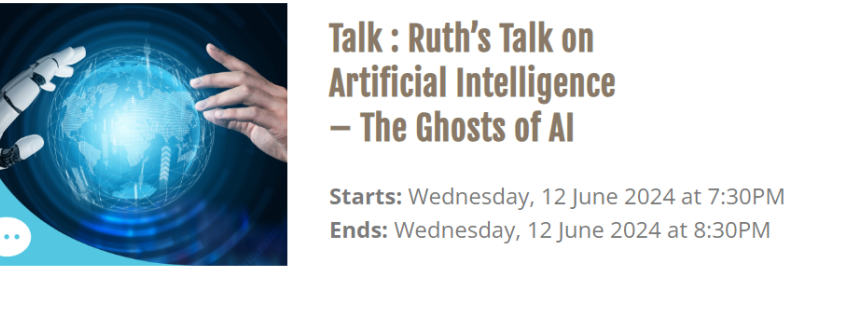Ruth’s AI talk on the WI Learning Hub: Wednesday 12th June 7.30pm
In March last year (2023) my Women’s Institute (WI) group, Gothic Valley WI (GVWI), shifted our meeting online due to a tube strike, and as ChatGPT was all in the news, I shyly offered to give a talk on artificial intelligence (AI).
I was shy about it, because even though GVWI shares many inspiring activities from sword fencing to kombucha making, and visits to the Vagina Museum and Chelsea Physick Gardens amongst many others, I still wasn’t sure how everyone would feel spending their evening learning about AI.
Our President and the committee were sure. They were very kind and enthusiastic saying that it was a bloody brilliant idea which was completely encouraging and totally in keeping with GVWI principles and the WI as a whole. We wish to share our skills and experiences with each other and our community to be a force for good. Consequently, giving my talk was a lovely experience.
As AI keeps on appearing in the news, I have long felt that it is imperative that all women, who remain a minority in the technology industry, but who make up 50% of the population, know exactly how AI and software works because introducing any new software is a political act. Once you introduce a new software in an app on a mobile phone, or into the software people already use, you change how people work – for better or for worse – and that is a political act. And, political acts should help all of the population not just make money for 50% of it.
Women who know exactly how AI works can have effective and balanced conversations on how it and any other technology can be most appropriately used within our communities for the benefit of everyone.
Women who know exactly how AI works can have effective and balanced conversations on how it and any other technology can be most appropriately used within our communities for the benefit of everyone.
Ruth Stalker-Firth
Before I felt the support of my WI group I wasn’t sure how I could make this happen, even though I have talked with so many women who run successful businesses and like the majority of women, are responsible for so much of the smooth running of society, in spite of not knowing exactly how AI and computing works. They would like to, but just have to take some bloke’s badly explained word for it because the field of computing is not a place that welcomes women and it is not easy to catch up on computing knowledge on your own. To make it more inclusive we need for women to have equal pay, role models, stories of said role models, tribes and respect.
And let’s be honest, a lot of computing information is very badly written. Go ahead and search online for a simple explanation of how Turing’s machine works, or how a neural net works. Every explanation or video I have looked at online, bandies about the word simple, but is anything but. Not because these concepts are difficult to understand, it’s just that they are just badly explained which makes them difficult to understand.
Once explained well it becomes easy to see that AI is just a tool and like all technology, it is an extension of us which is why AI seems to embody our fears and hopes, even though, spoiler alert, it isn’t capable of rising up and turning us all into batteries to power the robot revolution anytime soon, if ever.
So with all of this in my mind, I contacted the newly established WI Learning Hub which has been designed for WI members to upskill online , but is open to everyone, and they invited me to give a talk on AI on Wednesday 12th June 2024 at 7.30pm BST.
Ruth’s AI talk on the WI Learning Hub: Wednesday 12th June 7.30pm
It will be a light hearted look at the history of AI from it’s beginnings in 1956 when John McCarthy defined the term after his call to attend the Automata Studies summer project had most people asking: What are you are talking about John?… to the present day with ChatGPT4, the biggest large language model (LLM) to date that works just like predictive text on your phone.
We will look at how the hyperbole got started almost on day one when researchers believed their own hype. One excellent example of this is Marvin Minsky, the man who designed the first robot arm back in 1968 which led him to write The Society of Mind, (1985), a ‘classic’ AI text, like many computing books doesn’t concern itself with being readable as it’s a jumble of all of his ideas from when he was working with the robot arm. He also advised Stanley Kubrick on the set of 2001 A Space Odyssey, which is perhaps why, in spite of him being at the original AI Summer Project of ’56, he still said:
In from three to eight years we will have a machine with the general intelligence of an average human being. I mean a machine that will be able to read Shakespeare.
Marvin Minsky, Life Magazine, November 1970
Which made Lofti Zadeh, the inventor of fuzzy logic ask:
Why did you say that?
To which Minsky replied:
I dunno, I just got carried away.
And, whilst Minsky was carried away imagining space travel on set with Stanley, it was the women at NASA such as rocket scientist Annie Easley, mathematician Katherine Johnson who did the calculations that were written in code by FORTRAN pioneer Dorothy Vaughan and, computer scientist and inventor of software engineering, Margaret Hamilton. Role models and pioneers whose stories were never told to me a female computer scientist at anytime throughout all of my education.
The code was then sent it to a team of expert seamstresses at a nearby factory who sewed each 1 and 0 of binary code in copper, hardwiring it into the Eagle so Neil Armstrong could take his one small step onto the moon the following year. (Hamilton, had already created her own sentient being, her daughter, whom she brought to work on many occasions.)
It was software engineering which helped AI sort out its coding problems to get the bits that could work, actually working, which eventually led to the first ‘winter’ of AI (1972-80), when much of the AI funding was cut, as a lot of what AI said it was going to do was already being done by computer science at a fraction of the cost. Well along with that 1969 paper Minsky wrote to prove how Perceptron the first neural net didn’t really work.
AI, whilst swathed in myth and hyperbole, is actually a very human endeavour indeed, driven, as it is, by fiction, fashion and finance.
Ruth Stalker-Firth
In my talk, I will explain in the most accessible ways possible exactly how AI works – symbolic and statistical AI – and the reasons as to why researchers still believe that old, old story of the ghost in the machine quietly learning and becoming a sentient intelligent being through a unified theory of learning. AI, whilst swathed in myth and hyperbole, is actually a very human endeavour indeed, driven, as it is, by fiction, fashion and finance.

I hope to see you there!






